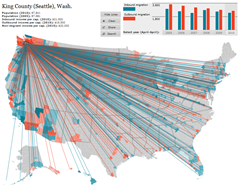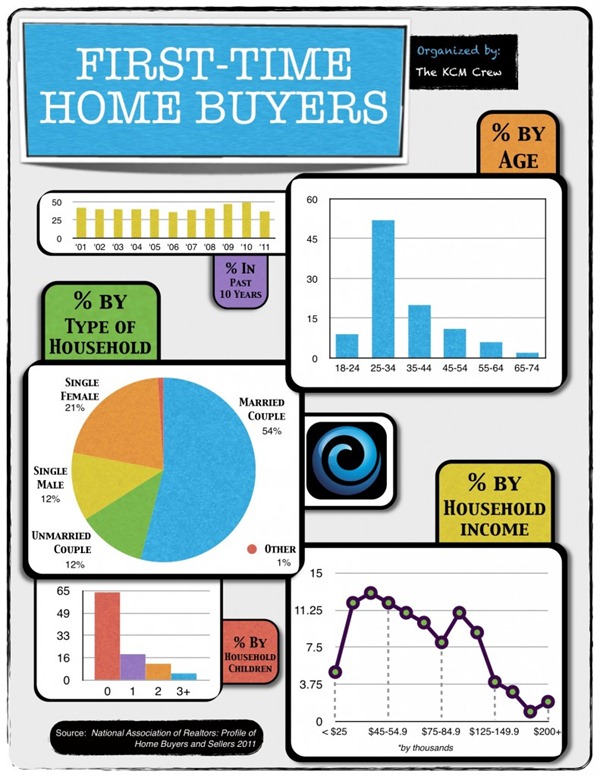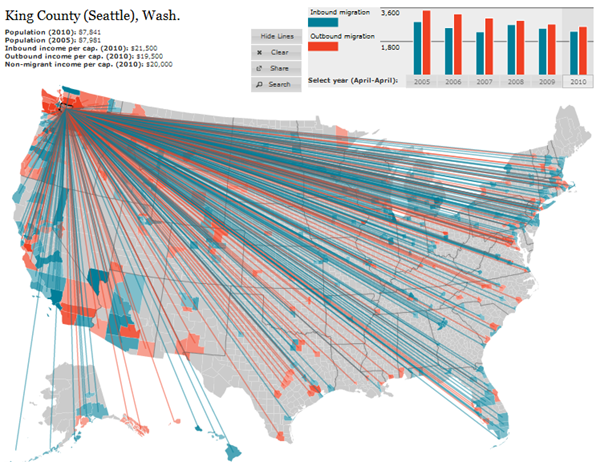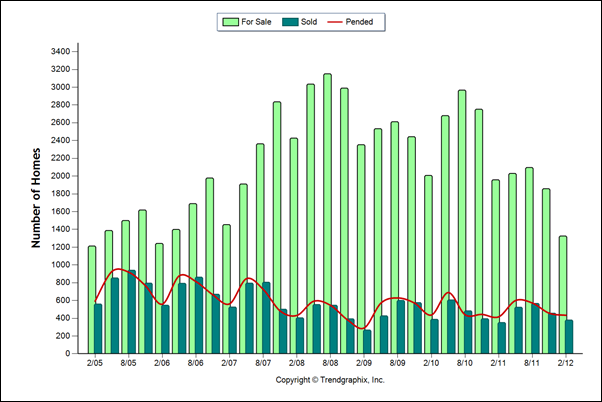created by KCM crew
First Time Buyers: The Stats
New-Home Design Trends Amp up Creativity but Cut Costs
 The hottest design trends in new homes this year incorporate creative use of materials, layouts and features that provide maximum utility and beauty while being cost-conscious at the same time, according to the National Association of Home Builders (NAHB). In celebration of April’s New Homes Month, NAHB shares the following top trends highlighted by leading home builders and architects during the International Builders’ Show in Orlando, Fla., this past February:
The hottest design trends in new homes this year incorporate creative use of materials, layouts and features that provide maximum utility and beauty while being cost-conscious at the same time, according to the National Association of Home Builders (NAHB). In celebration of April’s New Homes Month, NAHB shares the following top trends highlighted by leading home builders and architects during the International Builders’ Show in Orlando, Fla., this past February:
Reworked Spaces: New homes are being designed to allow plenty of space for family interaction in high-traffic areas such as the kitchen, and to eliminate rooms such as formal dens and home offices that aren’t frequently used. Small spaces devoted to home management, also known as “pocket offices,” are being included in large pantries or spaces nearby the kitchen or family great room. Window seats and alcoves are being used to provide an area for private time, without taking up a lot of space. A popular and efficient location for laundry facilities is now added onto the master bedroom’s walk-in closet.
Expanded Amenities: Multifamily development designs are increasing the number of resident amenities in order to compensate for smaller unit sizes. Gyms and media rooms have been common for years, but facilities such as libraries and business lounges with individual workspaces are now being offered as well.
Multigenerational Living: Many families are all living under one roof due to increasing cultural diversity and the state of the economy during the past few years. New single-family home designs reflect this with “shadow” units that are built alongside a home, or separate living units that access the main floorplan through a door, or homes with at least two master suites—often with one located on the ground floor to be more accessible for elderly occupants.
More Impact, Less Cost: Rectangular home designs are more cost effective, so new homes no longer have the formerly-popular feature of multiple roof lines or the resulting unnecessary interior volumes they created. But home designs now include innovative modifications that are still visually stimulating, such as using two windows in a corner with mitered glass to allow unobstructed views and maximum light to come in. Another example is using a mix of materials in the home’s façade such as metal, wood and stone to give the home a modern look.
The latest new home design trends that support modern lifestyles are just one of the many reasons to buy a newly-constructed home. Safety, energy efficiency and near record-low interest rates and competitive prices make today’s new home market an attractive opportunity for many families.
For more information, please visit www.nahb.org
FHA Clarifies New ‘Credit Dispute’ Rule
 The Federal Housing Administration is giving borrowers a chance to provide an explanation on any disputed collection accounts in their history in order to qualify for an FHA-backed mortgage. The new FHA rule took effect April 1 and had some in the real estate community concerned that it would shut more buyers out of qualifying for mortgages.
The Federal Housing Administration is giving borrowers a chance to provide an explanation on any disputed collection accounts in their history in order to qualify for an FHA-backed mortgage. The new FHA rule took effect April 1 and had some in the real estate community concerned that it would shut more buyers out of qualifying for mortgages.
According to the FHA’s new rule, borrowers with any credit disputes of more than $1,000 on their file will not be able to get a government-backed loan. Borrowers will either have to pay the remaining balance of the credit amount or show proof of entering into a payment plan for it.
The FHA is easing those restrictions somewhat, according to new instructions it provided to lenders, HousingWire reports. Borrowers will be exempt from the new rule if the credit amount is from a “life event.” This might include a medical bill, death, divorce, or unemployment, HousingWire reports.
"The borrower may provide a written explanation and documentation as it applies to all types of disputed and collections accounts if it makes sense, and is consistent with other credit information in the file," according to instructions provided to lenders.
Also starting on April 1, the FHA raised its insurance premiums, citing it as another effort to try to rebuild its emergency fund, which has fallen below the mandated amount Congress requires.
Source: “FHA Eases New Rule on Collections Accounts,” HousingWire (April 3, 2012)
More Generations Live Under One Roof
 A growing number of families are moving in together, which sometimes means that three generations are living all under one roof.
A growing number of families are moving in together, which sometimes means that three generations are living all under one roof.
The sluggish economy has caused some households to expand, taking in more family members to trim housing costs.
According to Census Bureau data, 4.4 million households had three generations or more under one roof in 2010. That is a 15 percent increase compared to two years prior.
The “double-up” phenomena is particularly pronounced among adult children, who are increasingly moving back with their parents after college to curb costs. The number of 25-to-34 year olds living with their parents jumped by more than 25 percent between 2001 and 2007, according to Census data.
The larger household sizes are causing builders to take notice and redesign floorplans to accommodate multi-generational households. For example, Pulte Homes says it’s swapping out one of the garages in its two-car garage plans to allow for extra space in a home for a guest room. And Toll Brothers reports that it’s creating new floorplans to accommodate multiple generations, such as a guest suite with a kitchen added where a family room may have once been.
Source: “The New American Household: 3 Generations, 1 Roof,” CNNMoney (April 3, 2012)
American Migration [Interactive Map]
 Another reason to be encourage here in King County. Migration is steady and healthy.
Another reason to be encourage here in King County. Migration is steady and healthy.
Close to 40 million Americans move from one home to another every year. Click anywhere on the map below: blue counties send more migrants to the selected county than they take; red counties take more than they send. Updated on February 24, 2012 | By Jon Bruner | More about the map >
click map to choose another county
Housing Is ‘Awakening From Hibernation,’ Freddie Says
 An improving economy is contributing to a gradual rebound in home prices across the country, according to mortgage giant Freddie Mac’s 2012 Economic Outlook report, released Wednesday. But there is still a way to go in the road to recovery for the housing market, the report noted.
An improving economy is contributing to a gradual rebound in home prices across the country, according to mortgage giant Freddie Mac’s 2012 Economic Outlook report, released Wednesday. But there is still a way to go in the road to recovery for the housing market, the report noted.
“The housing market is showing some signs of shaking off the depression-like conditions that have plagued it for much of the past few years,” according to the report. “As if awakening from hibernation, housing starts and home sales moved to higher levels of activity.”
In fact, the signs have prompted Freddie Mac to revise its forecast upwards for home sales and originations. One economic contributor that’s helping to stabilize housing: The drop in the unemployment rate to 8.3 percent, its lowest level in three years, according to the report.
“A variety of encouraging indicators suggest that the housing market may be feeling a nascent recovery … and more neighborhoods may see a stabilization in overall demand and housing values this spring,” says Frank Nothaft, Freddie Mac’s chief economist.
Median home sale prices are up, despite a slight drop in new and existing home sales, Freddie Mac reports. About a half of the increase in housing starts has been for construction of rental apartments in multi-unit buildings to meet the increasing demand, the report notes. New rental construction, at its current pace, is expected to reach its highest level since 2005.
“Housing starts continue to run below net household formations [and will allow for absorption of existing vacant homes],” according to the report.
Source: “Freddie Mac: Economic Growth Expected to Stabilize Housing Market,” Dow Jones Newswires (March 28, 2012)
4 Reasons Why Our Seattle Real Estate Market Is In Good Shape
 I was in a conversation with someone today asking about the future of real estate. There is so many horror stories that it is easy to get lost in the negative emotions, and miss the fundamentals of what constitutes a healthy real estate market.
I was in a conversation with someone today asking about the future of real estate. There is so many horror stories that it is easy to get lost in the negative emotions, and miss the fundamentals of what constitutes a healthy real estate market.
Here’s what is going on in the greater Seattle area as it pertains to real estate. 4 reasons to have a positive outlook on our market.
-
Inventory levels are as low as they have been in 7 years. Though there are a variety of reasons for this, the amount of homes impacts prices and consumer action.
-
Due to the recession, there has been very little new construction over the past 5 years. Thought builders are coming back into the market, it takes time for the homes to be built. In the areas with quality new construction, builders are raising prices.
-
Local economy is healthy and improving. Jobs (tech and others – Boeing has 32 years worth of planes to build) and migration (Washington is #5 in the Nation in migration rates) point to a pent-up demand and lack of inventory.
-
There’s been a lot of talk about “Shadow Inventory” (homes that haven’t been foreclosed yet but will eventually be sold at auction). Lenders aren’t going to hurt their own best interests by “flooding the market”, it’s not going to happen. In most cases, the investors who purchase foreclosed properties are holding the properties as rentals. There will always be foreclosures; the smart money is on a balanced drip of homes into the marketplace.
A graph of Seattle for the past 7 years (by quarter).
Are We In A Housing Recovery?
 Pundits and professionals give varying answers to the question of what a housing recovery looks like. According to the Housing Guru Blog, some see it as a return to the home values seen before the crash; others define it as the annual rate of over 8 million sales. And still another camp believes that neither picture is realistic.
Pundits and professionals give varying answers to the question of what a housing recovery looks like. According to the Housing Guru Blog, some see it as a return to the home values seen before the crash; others define it as the annual rate of over 8 million sales. And still another camp believes that neither picture is realistic.
Economist Paul Dales at Capital Economics notes that Americans ought to pay greater attention to a different indicator — accelerated home sales. CNN Money reports that existing home sales reached 4.26 million in 2011, up from 4.19 million transactions in 2010. And in the past six months, total homes sales have gone up by 13%. The positive growth in sales is a sign that the market is recovering. Additionally, if the benchmark of health is an inventory at or below 6 months, then January’s supply of 6.1 months is good news. But it gets complicated. Some analysts were disappointed by February’s numbers, particularly with the slight fall impending home sales by one half of a percent month-over-month. All eyes will be on March’s stats.
In spite of what appears to be a sluggish recovery, housing continues to be more affordable than renting, due in large part to cheap interest rates and low property prices. Trulia reports that in 98 out of the top 100 housing markets, buying is indeed more affordable, the two exceptions being Honolulu and San Francisco. Cities that have strong long-term growth prospects and limited land to expand should expect to see a rebound in prices over time, whereas older areas with limited growth may remain static. So there’s more than one way to look at recovery, and the expectation that housing prices regain pre-recession levels may be neither feasible nor desirable.
Let me know how I can help: 206-713-3244 or email me.



